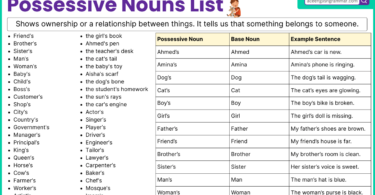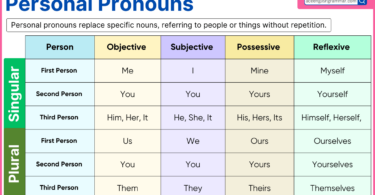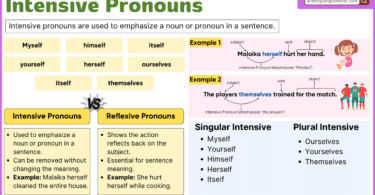In the realm of grammar, verbs are categorized into two fundamental types: finite and nonfinite. Nonfinite verbs don’t have a specific tense and cannot stand alone as the main verb. They come in three forms: gerunds, participles, and infinitives. In this article, we will focus on gerunds. Gerunds are one of the most confusing grammatical concepts in the English language. For those who are not familiar, gerunds may seem like just another type of verb form. However, they have a unique function and are used in various ways. So what gerunds are, how they are formed, their types with examples, and how to use them effectively let’s dive in and find out.
Table of Contents
What is a Gerund?
An -ing form of a verb that acts as a noun in a sentence is called a gerund. Gerunds, like a noun, function as a subject, object, or complement in a sentence. Gerunds can be modified by adjectives, adverbs, and phrases. They also serve many functions in a sentence, including acting as a subject, (Swimming is my favorite way to exercise), as an object, (I enjoy baking cookies), or as a complement, (My favorite hobby is reading books). It is important to note that gerunds are not the same as participles, which also end in “-ing” but function as adjectives. Gerunds and participles can be easily confused, but one way to distinguish between them is to look at their function in the sentence.
Examples:
- Swimming is my favorite hobby. (subject)
In this sentence, the gerund “swimming” is not an action verb, no one is swimming here. It’s just representing the action of swimming and functioning as a noun.
- She enjoys reading (object)
Here “reading” is a gerund functioning as the direct object of the verb “enjoys.” It answers the question, “What does she enjoy?” The gerund “reading” represents the activity of reading books.
- His passion is writing. (complement)
In this sentence, “writing” is the subject complement. It renames and describes the subject “His passion.” The gerund “writing” acts as a noun, indicating what his passion is.
Formation of Gerunds
- Add -ing to regular verbs: Walk → Walking
- Drop -e from verbs ending in -e: Dance → Dancing
- Double the final consonant in one-syllable verbs with a single vowel + consonant: Run → Running
- Memorize irregular verb forms: Go → Going
- Maintain -ing for verbs ending in -ee: See → Seeing.
- Change -ie to -y and add –ing: Die → Dying
Gerunds vs Infinitives
Gerunds and infinitives are both verb forms, but they are used differently. A gerund is a verb with an “-ing” ending, like “swimming” or “eating.” It acts as a noun and is used for actions as subjects or objects, like “I love swimming.” On the other hand, Infinitives are the base form of a verb, like “to swim” or “to eat.” They can act as nouns, adjectives, or adverbs, and often follow other verbs, like “I want to swim” (where “to swim” is the infinitive). In some cases, both gerunds and infinitives can be used, but the meaning may change slightly. Here are some examples:
- I like to swim. (Infinitive, expressing general preference)
- I like swimming. (Gerund, expressing a specific activity)
No Tense in Gerunds: (unrestricted)
Gerunds are not concerned with tense (present, past, future), numbers (singular, plural), and persons (1st, 2nd, or 3rd).
- No tense: Unlike regular verbs, gerunds do not have tense. They are not concerned with when an action occurs. Instead, the surrounding words and context determine the time frame.
- No Numbers: Gerunds are always singular; they do not change to reflect singular or plural forms. For example, “reading” can refer to one person reading or multiple people reading.
- No Persons: Gerunds do not have person distinctions (first person, second person, third person). They are neutral in terms of the doer of the action.
Gerund vs Participle
Gerunds and participles are both forms of verbs, but they serve different purposes in sentences. Gerunds end in “-ing” and act as nouns, representing actions or activities, such as “swimming” in “I love swimming.” Participles, on the other hand, can end in “-ed,” “-en,” or “-ing” and function as adjectives or part of verb tenses. For instance, in “The painted house is beautiful,” “painted” is a participle describing the house, and in “She had eaten breakfast,” “eaten” is part of the past perfect tense. In summary, gerunds act as nouns, while participles are used as adjectives or verb components.
Types of Gerunds
There are several types of gerunds, each serving a different purpose and providing specific information in a sentence. Here are some basic types of gerunds with examples:
Subject Gerunds: These gerunds function as the subject of a sentence and represent an action or activity. For example:
- Swimming is my favorite sport.
- Cooking takes time and patience.
Object Gerunds: They serve as the direct object of a verb, typically indicating what the subject is doing. For example:
- She enjoys reading
- He started learning Spanish last year.
Possessive Gerunds: These gerunds show possession or ownership of the action or activity. For example:
- I don’t mind your singing.
- She’s proud of his cooking
Gerunds after Prepositions: They often follow prepositions and are used to show the relationship between the action and other elements in the sentence. For example:
- He’s good at solving
- She’s interested in learning about history.
Gerund as Object Complement: Gerunds can also act as object complements, providing additional information about the direct object. For example:
- She considered him a great teacher.
- I find the movie entertaining.
Gerund as Part of Compound Nouns: In some cases, gerunds are used to form compound nouns. For example:
- The swimming pool is open all year.
- I bought a book on cooking techniques.
Gerund in Infinitive Phrases: They can appear in infinitive phrases, where they complement an infinitive verb. For example:
- She decided to go swimming in the afternoon.
- He plans to start learning a new language.
Gerund phrases
Gerund phrases are phrases that include a gerund (a verb form ending in “-ing”) along with other words that modify or complement it. There are several types of complements that can be associated with gerund phrases, including direct objects, indirect objects, and prepositional phrases. Here are some examples of gerund phrases:
Examples:
- Exercising regularly is essential for good health.
- She enjoys reading historical novels.
- The most enjoyable thing is spending time with friends.
- She apologized for interrupting the meeting.
- I like watching movies in my free time.
- We are looking forward to meeting you.
Examples Sentences of Gerund
- I enjoy reading
- She likes playing with friends.
- She hates cleaning the house.
- We started working on the project.
- He finished reading the book.
- They kept practicing.
- Painting is a form of self-expression.
- We should avoid making
- I recommend watching that movie.
- She considers the movie worth watching.
- We practice speaking English every day.
- I can’t help laughing.
- She avoids eating junk food.
- Gardening is my favorite hobby.
- I regret not studying harder for the exam.
- She apologized for making a mistake.
List of Words Followed by Gerunds
- Enjoy
- Like
- Love
- Hate
- Start
- Finish
- Admit
- Avoid
- Consider
- Advice
- Imagine
- Suggest
- Appreciate
- Recommend
- Miss
- Delay
- Practice
- Acknowledge
- Can’t help
- Mind
- Stop
- Keep
- Continue
- Begin
- Dislike
- Forgive
- Celebrate
- Discuss
- Prevent
- Risk
- Deny
- Resist
- Regret
- Defer
- Urge
- Try
- Quit
FAQs
Q1: What is a gerund?
A gerund is a verb form ending in “-ing” that functions as a noun in a sentence.
Q2: How do you form a gerund?
To form a gerund, add “-ing” to the base form of a verb, such as “running,” “swimming,” or “eating.”
Q3: What is the difference between a gerund and a present participle?
Both gerunds and present participles end in “-ing,” but gerunds function as nouns, while present participles are part of verb tenses (He is running. uses “running” as a present participle).
Q4: How do I distinguish between gerunds and participles in a sentence?
Look at the function of the word in the sentence. If it acts as a noun, it’s a gerund; if it modifies a noun or is part of a verb tense, it’s a participle.
Q5: Give some examples of gerunds.
- Swimming is great exercise (subject)
- I enjoy reading books (direct object)
- She’s interested in cooking (object of a preposition)
- His favorite activity is hiking (complement of a verb)
- I can’t help laughing at his jokes. (can’t help





Leave a Comment